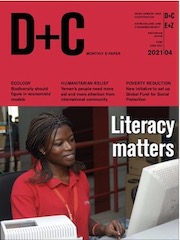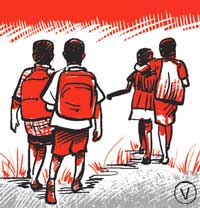
Related posts >>
Sarva Shiksha Abhiyan is an effort to universalise elementary education by community-ownership of the school system. It is a response to the demand for quality basic education. The SSA programme is also an attempt to provide an opportunity for improving human capabilities to all children, through provision of community-owned quality education in a mission mode. […]
The Sarva Shiksha Abhiyan is to provide useful and relevant elementary education for all children in the 6 to 14 age group by 2010. There is also another goal to bridge social, regional and gender gaps, with the active participation of the community in the management of schools.
Useful and relevant education signifies a quest for an education system that is not alienating and that draws on community solidarity. Its aim is to allow children to learn about and master their natural environment in a manner that allows the fullest harnessing of their human potential both spiritually and materially. This quest must also be a process of value based learning that allows children an opportunity to work for each other’s well being rather than to permit mere selfish pursuits. […]
Source: Sarva Shiksha Abhiyan | Overview
Address : http://hp.gov.in/SSA/page/ssa-overview.aspx
Date Visited: Mon Dec 05 2011 11:22:54 GMT+0100 (CET)
Education of girls, especially those belonging to the scheduled castes and scheduled tribes, is the primary focus in Sarva Shiksha Abhiyan. Efforts will be made to mainstream gender concerns in all the activities under the Sarva Shiksha Abhiyan programme. Mobilization at the habitation/village/urban slum level, recruitment of teachers, upgradation of primary into upper primary schools, incentives like midday meals, uniforms, scholarships, educational provision like textbooks and stationery, will all take into account the gender focus. Every activity under the programme will be judged in terms of its gender component. Besides mainstreaming, special efforts like the Mahila Samakhya type of mobilization and organization, back-to school camps for adolescent girls, large-scale process based constitution of Mahila Samoohs, will also be attempted. The selection criteria takes into account the low female literacy among the scheduled caste and scheduled tribe women. […]
5.1.4 INTERVENTIONS IN TRIBAL AREAS
The problems faced by children in the tribal areas are often different than that faced by children belonging to Scheduled Castes. Hence, special interventions may be needed for such regions. Some of the interventions, which can be considered, are:
- Textbooks in mother tongue for children at the beginning of Primary education where they do not understand regional language.
- Bridge Language Inventory for use of teachers.
- Aganwadis and Balwadis or crèches in each school in tribal areas so that the girls are not required to do baby-sitting.
- Special training for non-tribal teachers to work in tribal areas, including knowledge of tribal dialect.
Source: SARVA SHIKSHA ABHIYAN
Address : http://education.nic.in/ssa/ssa_5.asp
Date Visited: Mon Dec 05 2011 11:17:33 GMT+0100 (CET)
Research the above issues with the help of Shodhganga: A reservoir of theses from universities all over India, made available under Open Access >>
Posted by shantanu dutta
Tuesday, March 3, 2009 at 9:34 AMA school that I visited last week in Dehradun awakened me to one of the many changes that are quietly taking place in the country. […]
Contrary to the usual belief that nothing in the government works, the SSA is a great endeavor to universalize elementary education. […]
Although, there is no doubt that the average drop-out rate in primary classes suggests a consistent decline; but the same is still too high to attain the status of universal retention at the primary level of education. Universalisation of education comprises four components- universal access, universal enrolment, universal retention and universal quality of education. […]
As always, it is evident most effectively not in figures but in real life stories like the children in the school I visited in Dehradun last week, whose education is being taken care of by the Sarva Shiksha Abhiyan. And for once I am happy that the educational surcharge levied every time I pay a service tax on any transaction is reaching the right people in the right way, and the government machinery is working. The story is not all bad.
Source: Around and About: Educating our Kids : The Sarva Shiksha Abhiyan
Address : http://fifthwiseman.blogspot.com/2009/03/educating-our-kids-sarva-shiksha.html
Date Visited: 11 June 2021
Tips
- For more information, type “Sarva Shiksha Abhiyan”, “literacy tribal community” or similar search terms into the search window here: Google custom search – Indian press coverage of tribal culture and education >>
- Do the same on Custom search engine: Govt. of India, NGOs and international organisations >>
“The Big-brother attitude of educators must end. The approach to tribal education has to be a two-way transaction of give and take, based on an informed appreciation of traditional tribal values and wisdom.” – Uma Ram (Professor & Head Department of English, Kakatiya PG College, Chhattisgarh) in Issues in Tribal Education in Bastar, Chhattisgarh (Folklore Foundation, Lokaratna, Volume IV 2011)
Residential, Ashram and Factory schools
- Ekalavya* Residential School Scheme (EMR): a network of boarding schools where tribal children are to be educated in accordance with rules and syllabi provided by the government; such schools are being designated as “Eklavya Model Residential School (EMR)” with the objective of empowering students “to be change agent, beginning in their school, in their homes, in their village and finally in a large context.” – Government Guidelines 2010 | Backup >>
- Residential School and Ashram School
In some regions there are similar “Residential Schools” and “Ashram Schools” for tribal children, as in Tripura where they are managed by a society called “Tripura Tribal Welfare Residential Educational Institutions Society (TTWREIS)” – Tribal Welfare Department, Government of Tripura - Factory schools “exist to turn tribal and indigenous children – who have their own language and culture – into compliant workers-of-the-future. The world’s largest Factory School stated that it turns ‘Tax consumers into tax payers, liabilities into assets’.” – survivalinternational.org/factoryschools | Learn more >>
Up-to-date information about these and related issues: Safe custom search engine >>
* Ekalavya (Eklavya, Eklabya): the name of a legendary archer prodigy “who, being a Nishada [Sanskrit Niṣāda, “tribal, hunter, mountaineer, degraded person, outcast”], had to give his thumb as a fee to the brahmin guru thus terminating his skill as an archer.” – Romila Thapar (“The epic of the Bharatas”) | Read the full paper here | Backup download link (pdf) >>
Note: “Forcibly transferring children of the group to another group” amounts to genocide, which the United Nations Office on Genocide Prevention defines as “acts committed with intent to destroy, in whole or in part, a national, ethnical, racial or religious group” (Article II, d & e)
Learn more about Childrens rights: UNICEF India | Ekalavya (Eklavya, Eklabya), EMR & Factory schools | Rights of Indigenous Peoples >>
Tip: click on any red marker for details on endangered languages in a particular region of India.
Please note: the facts and figures cited (via hyperlinks) links call for updates and fact checking >>
Cultural invisibility – India’s 600 potentially endangered languages | Linguistic Survey of India (official website) >>
